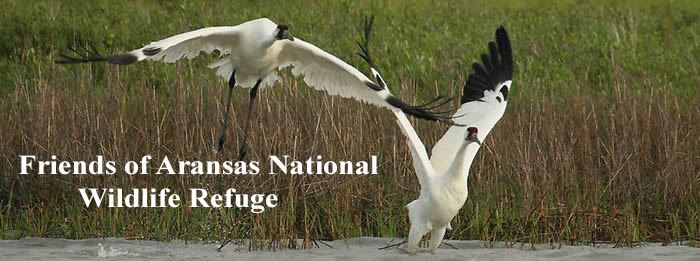Wade Harrell, U.S. Whooping Crane Recovery Coordinator
It continues to look like a banner year in terms of habitat conditions, with the Refuge having a greater amount of freshwater on the landscape than we have seen in several years. Fall and winter rains are slowly moving us in the right direction. Whooping Cranes have responded to these conditions by spending more time in the coastal marsh, foraging on the relatively abundant blue crabs and other food resources. While we have still seen some Whooping Crane use of inland habitats this year, that trend is definitely down from the peak of the drought 2 seasons ago.
Visitors to the Refuge and those observing Whooping Cranes from boat tours have been in a good position this year to observe use of the traditional coastal marsh habitat. We’ve had some outstanding weather lately, and I encourage everyone to come out and visit us before the Whooping Cranes start heading back North in late March. Many of you will be happy to know that we have reinitiated our Refuge bus tours for February and March. Tours are first-come, first-served, and visitors must register in the visitor center the day of the tour. The schedule is as follows:
Thursday, 1:00 – 3:00 p.m.
Friday, 1:00 – 3:00 p.m.
Saturday, 10:00 a.m. – 12:00 p.m. and 1:00 p.m. – 3:00 p.m.
Sunday, 10:00 a.m. – 12:00 p.m. and 1:00 p.m. – 3:00 p.m.
Information on Whooping Crane Death Being Sought
The U.S. Fish & Wildlife Service and Texas Parks & Wildlife are seeking information about the death of a Whooping Crane. The carcass of the bird was found on January 4. For more information, please see the press
release.
Training Surveys & GoPro Video
We were able to fly some training surveys on January 5-6 with our new Refuge Biologist Keith Westlake and Ecological Services biologist Frank Weaver. We are still working through the best way to utilize GoPro Camera technology in our survey efforts, but have some clips of how things look 200 feet above the marsh. We’ll be uploading the survey clips on our Facebook page, so check it out in the coming week.
GPS tracking study & other Whooping Crane observations
While we have not done any additional marking of Whooping Cranes this winter, we are still consistently tracking 20 GPS marked Whooping Cranes for this study. They also have bi-color bands on the leg opposite of the leg with the transmitter. If you happen to see a marked bird, please report it to us with as much information as you can (i.e. Red/Black left leg, GPS right leg, location, other birds in the same area, etc.)
Whooping Cranes outside the traditional wintering area that have been reported to Texas Whooper Watch include a single adult bird associated with a group of Sandhill Cranes in Eastern Williamson County, a pair of adult Whoopers near the town of Refugio, and a pair of adults with 2 juveniles in Northwest Matagorda County,
Habitat Management on Aransas NWR:
The Refuge successfully conducted 3 burns this winter, 2 on the Blackjack Peninsula along East Shore Road (primary Whooping Crane habitat) and one on Matagorda Island. Total acreage burned was more than 12,000 acres.
Recent Precipitation/Salinity around Aransas NWR:
December precipitation: 2.95” @ Aransas HQ
January precipitation: 2.85” @ Aransas HQ
February precipitation (as of Feb. 22): 0.93” @ Aransas HQ
Salinity at GBRA 1: averaging around 24 ppt
